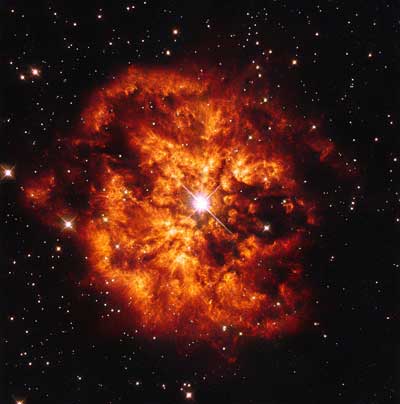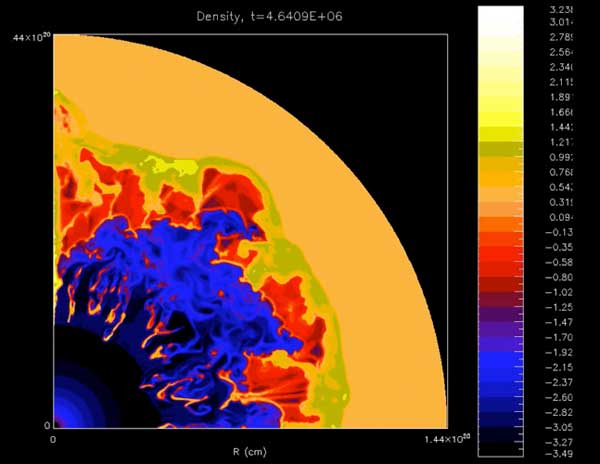A new theory of the solar system’s formation suggests that it formed within the shell of a wind-blown bubble surrounding a dead star.

ESA / Hubble & NASA; Acknowledgement: Judy Schmidt (geckzilla.com)
From one star’s ashes, another is born. Astronomers have long known that most of the elements in the periodic table are synthesized within the nuclear furnaces that shine in the night sky. Then, when those stars meet their end, they fling that material outward — seeding the cosmos with heavier elements that get swept up within the gas that will soon form new stars.
The Sun is no exception. But while the solar system surely formed out of the remnants of past stars, the specifics remain hotly debated.
Now, a new study published December 22nd in The Astrophysical Journal Letters argues that the Sun came together at the edge of a wind-blown bubble surrounding a dead star. The results suggest that the solar system formed in a slightly atypical environment.
Astrophysical Forensics
Although it might seem as though the formation of the early solar system has been lost to history, meteorites can bring tantalizing clues. In 1976, for example, scientists discovered that one meteorite contained the stable daughter isotopes of aluminum-26, causing them to argue that the early solar system was overflowing with the short-lived aluminum radioisotope.
For such a radioisotope to have been incorporated into the early solar system, scientists speculated that it must have been delivered by some nearby cataclysm — likely a stellar explosion. So, scientists suspected that a supernova ejected material into a dense cloud of interstellar gas and dust, causing it to collapse to form our Sun.
But more recent measurements led by co-author Nicolas Dauphas (University of Chicago) put a major bullet in that theory. In 2012, Dauphas and his team found too little iron-60 in several meteorites. It was an odd discovery given that a nearby supernova would have produced iron-60 along with aluminum-26.

V. Dwarkadas & D. Rosenberg
To explain the discrepancy, scientists had to determine how a supernova could eject one isotope and not the other. “That's too much hand-waiving and fine-tuning,” says lead author Vikram Dwarkadas (University of Chicago). So, he and his colleagues have turned toward another culprit: giant Wolf-Rayet stars that weigh in at 25 times the mass of the Sun.
Unlike supernovae, where dramatic explosions release elements into the cosmos, hot and luminous Wolf-Rayet stars fling elements off their surfaces in intense stellar winds. These winds contain plenty of aluminum-26, but very little iron-60. As such, Dwarkadas thinks they’re the perfect early trigger for our solar system’s formation.
A Wolf-Rayet’s winds plow through the material around the star, forming a bubble. “It's like a snowplow,” Dwarkadas says. “You’re going so fast, you just sweep up everything in front of you.”
The Sun could have formed within the walls of this vast cosmic bubble.
Specifically, the star ejects aluminum-26, carried on grains of dust. Those grains have enough momentum to punch through one side of the wall, depositing the aluminum within. Then, once the Wolf-Rayet star dies, the bubble’s wall cools and parts of it collapse to form new stars — including our Sun.
The Perfect Spot
Edward Young (University of California, Los Angeles) who was not involved in the study, agrees that Wolf-Rayet stars are the likely culprit. “You still see papers coming out saying that aluminum-26 tells us that there was a supernova-trigger for the solar system, but the vast majority, I think, of cosmochemists today will argue that that's just not right,” he says.
That said, Young disagrees that the Sun formed within the walls of a Wolf-Rayet’s wind-blown bubble. Instead, he argues that the Sun likely formed within a star-forming region that was simply polluted by nearby Wolf-Rayet stars. You might think that such a region would also be polluted by supernovae explosions, but Young argues that supernovae don’t occur all too often in such regions. That’s because supernovae form from stars smaller than Wolf-Rayets. These stars have longer lifetimes and therefore more time to travel far away from the star-forming region, while Wolf-Rayet stars have far less time and therefore mostly stay put. As such, iron-60 will be more evenly distributed throughout the galaxy, whereas aluminum-26 will be concentrated within the star-forming regions.
Young thinks this scenario is more likely because the amount of aluminum-26 discovered in meteorites matches the amount observed in star-forming regions so far. He also argues that it’s unlikely the Sun formed in an environment as special as the edge of a dead star’s wind-blown bubble. (Remember Occam’s razor, which argues that the simplest explanation is often the correct one).
The answer will ultimately shed light on whether the Sun’s formation is normal or wildly peculiar. “We want to know how our world formed to understand whether we are special — whether there is something inherently different about our world or whether it could be a commonplace event, which means that there could be other solar systems like ours, and potentially life,” Dwarkadas says.
Reference:
Vikram V. Dwarkadas et al. “Triggered Star Formation Inside the Shell of a Wolf-Rayet Bubble as the origin of the Solar System.” Astrophysical Journal Letters.
 1
1
Comments
Andrew James
January 5, 2018 at 10:09 pm
For me it seems far to easy to be true. Wolf-Rayets are very rare and we know little about their formation - and worse many are isolated away from nebulae (but not all.) It is more likely there were multiple scenarios happening in the original nebulae, and the formation of the element abundances depended on the time the Sun formed during the period of that nebula's lengthy evolution. The difficulty remains in how do you get enough 'Z' elements in the time of just 9 billion years to make the planets in the first place. (Assuming the Sun is 4 Gyr and the Universe 13 Gyr.) (Worst Gold or Uranium, etc., for example, are not likely to appear in Wolf-Rayet winds, but they do in supernovae.)
Young's / article's? comment "That’s because supernovae form from stars smaller than Wolf-Rayets" is unlikely too. Wolf Rayets have significant mass loss via superwinds, but the remaining mass rapidly reduces in size, and eventually destroys itself as a supernova. If it does, the supernova shockwave catches up with the older superwind material and intermixes with it. So would it not be logical that the Wolf-Rayet formed in the nebula, interacted with the nebula and enhanced it with aluminium-26, the supernova explodes, then next enhances it further with iron-60. The Sun is also unlikely to form is the boundary shock - not sufficient hydrogen and helium - but there is enough to form meteoric material as dust. This dust intermixes with the Sun's nearby globule or proto-nebula and accretes into planetary material.
(As for the snow-plow, the same could be said for planetary nebulae winds too, but such stars have long left their nurturing nebulae behind.)
As for Occam’s razor. If you use it to many times, the blade just gets too blunt to be effective.
Note: I am still giggling of the analogy of bullets and iron. Conjours up - I shot the nebula!
You must be logged in to post a comment.
You must be logged in to post a comment.